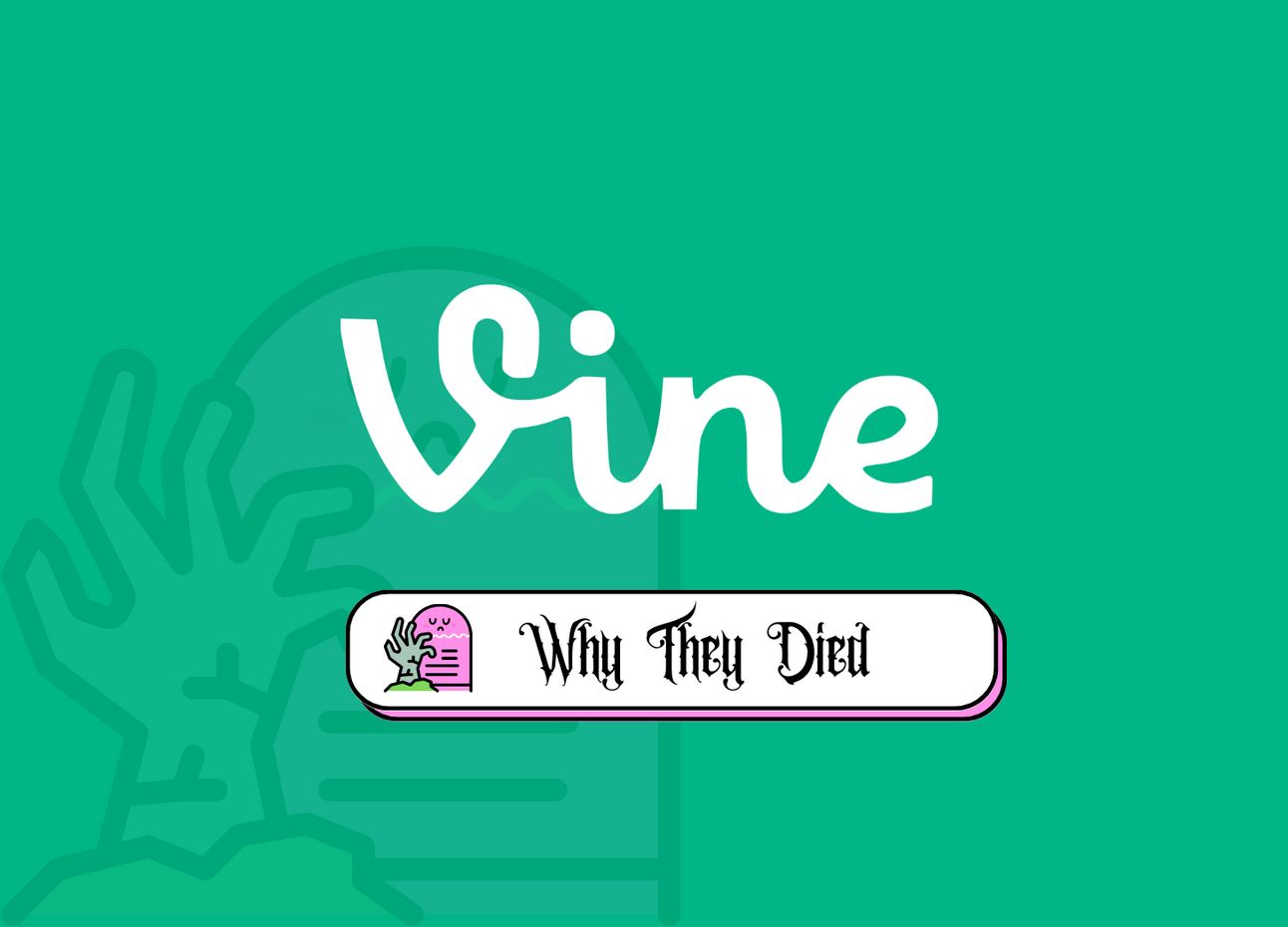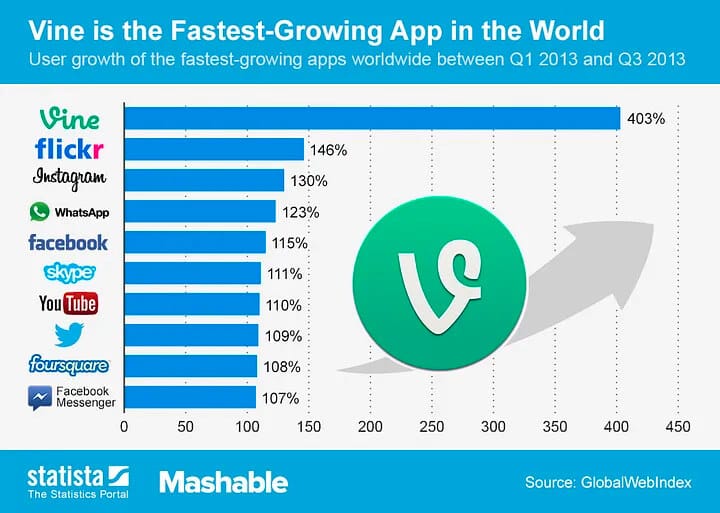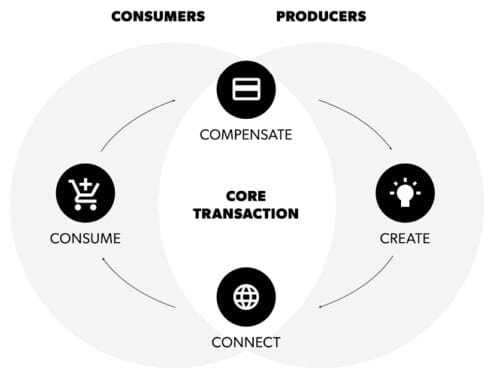- How They Grow
- Posts
- Why Vine Died: Closing The Loop On The Company That Changed The Internet
Why Vine Died: Closing The Loop On The Company That Changed The Internet
Lessons to be learned from our first trip to the startup graveyard.
👋 Welcome to the first edition of Why They Died. Your occasional trip to the startup graveyard, where we investigate what caused once high-flying companies to fail.

Hi, friends 🧟
Most startups don’t succeed. About 90% of them fail — 10% in just the first year. And of the startups that don’t shut down, many of them choose a worse fate. They operate in “zombie mode” — resistant to admit defeat and shut down, with no prospect of growth, sucking away resources that could be deployed elsewhere.
Clearly, starting a company and keeping it going is hard.
But you already know that.
This new series will attempt to help us get a better understanding of WHY. What are the red flags? What paths should we avoid on the trek to building an enduringly valuable product? And many more questions…
While How They Grow brings us consistent lessons from the successes of other popular companies, Why They Died is like its morbid sibling who will show up unannounced — sporadically popping into your inbox to bring you concrete lessons from the failures of once high-flying companies.
Billions and billions of dollars and countless decades of manpower have been invested in dead ends. Luckily for us, we can piggyback on all of it to help us make sure our products and ideas stand a better chance of avoiding the same fate.
To quote Warren Buffet again:
When I pitched this idea of an off-shoot series a few weeks ago, the response from you guys was alarmingly positive (95% of you “loved the idea”.) This made me really excited because I think balancing analyses on the good with the bad will make us better, more well-rounded, builders.
Knowing what to do is just as important as knowing what not to do.
As an aside, just to set expectations from the get-go; this series will be occasional, and it won’t be as in-depth as our main deep dives.
With that, we’ll be picking ventures that initially showed promise but subsequently crashed and closed their doors because of errors that could have been averted. There are lots of causes of death, but in each post-mortem, we’ll be looking out for common things like:
Great product, no market.
Great market, poor product.
Good product and market, bad business model.
Founder-market fit. No domain experience.
Bad bedfellows: VCs, partners, stakeholders.
No strategy. Bad strategy.
False starts. AKA MVPs launched without customer research.
Running out of money. Either not getting enough financing, burning through money faster than they could make it, or just failing to monetize entirely.
Failing to innovate/adapt and getting out-competed.
Bad timing.
Regulatory/legal challenges.
Founder burnout.
Lack of focus, taking on too many bets.
Growing too quickly.
Badly executed M&A.
And on our first trip to the startup graveyard, we’re visiting…Vine.

Obituary: Here lies Vine 🪦
01/24/2013 - 10/27/2016
There’s no doubt about it. Vine was a company that changed the internet. It was an absolute growth and cultural sensation, creating not just a new format of content, but a new category of entertainment. Short-form, user-generated, and homegrown “viral” videos.
And it happened by accident.
In 2012, three New Yorkers, Dom Hofmann, Rus Yusupov, and Colin Kroll, came together to make their own social networking app. A lofty and ambitious goal given the meteoric rise of Facebook.
The idea: one place to film, edit, and share casual moments in your life through video.
Initially, they planned to allow for unlimited runtime in videos — meaning if you felt like your day deserved a James Cameron-length feature film, go for it. But after some pre-launch testing, they realized the file sizes could be massive, making sharing a terrible experience. Let alone the hosting costs.
So, they landed on 6-second videos — what they believed to be the perfect length for our short attention spans. This was based on various studies showing something along the lines of, “you have about 6-8 seconds to capture people's attention. That's the length of the average attention span, and if you fail to capture the audience in that time, you've lost your chance to convert a potential customer.” This is a significant point…we’ll come back to this.
But, with more private testing, they found an issue with this short format. Videos in the feed were coming and going too quickly. So, they brilliantly landed on the novel concept of looping.
This combination—bite-sized content that looped—was the defining characteristic of their new social media contender. And this hook was so promising, that Twitter came along and bought them for $30M in October 2012.
Vine hadn’t even launched yet.
But 4 months later, on Jan 24th, they went live on the App Store. And they grew at an astonishing pace as people flocked to create and watch this brand-new type of content. In just 6 months, they racked up a solid 13M user count, were a front-runner for mobile video sharing, and reached the top of the Apple charts.

Part of the reason for this meteoric growth was that Vine wasn’t what the founders had envisioned. 🤔
Within just a couple of weeks of being out in the wild, the people made Vine into something else. Something much more culturally interesting and viral. The 6-second format pushed creators to be experimental and creative within the constraints. It wasn’t about journal entries to share those everyday moments. It was about what memes, gifs, funny skits, or viral trends you could squeeze into 6-seconds.
Homegrown video— the real, raw, and funny—it was deez things people went nuts for it.
While big celebs like Bieber hopped on the Vine train, the beauty of Vine was that it was minting a new genre of social media celebrity. Anyone could come on, gain attention and create a following, and start building a career off the back of it.
Much like how MySpace was for Facebook…Vine was the template in many ways for TikTok.
Which takes us to October 27th, 2016. After 4 years on the market, with 200M active users, Twitter told the world, via a Medium post, that Vine was done.
So…with such a meteoric rise, and clearly making something people wanted in a massive market…what happened?
Post-mortem: Closing the loop
In short — it was an unprofitable business that was eaten by the competition.
Of course, that alone is useless information. We need to unpack why.
This category of entertainment and social media was Vine’s to lose…which they did…so let’s look at how they dropped the golden egg.
Our startup autopsy suggests 4 causes of death:
Poorly executed integration by Twitter— no strategy.
Failing to innovate, move quickly, and meet market demand
Money problems
Getting swamped by competition
Let’s start with the little blue bird landing on Vine’s porch. 🐦
Poorly executed integration by Twitter— no strategy.
When Vine caught Jack Dorsey's attention, they were just three dudes with a beta app. They didn’t even know what they had yet, or what Vine could be. But they got paid $30M for it.
So, why did Twitter buy Vine?
Simply…because Facebook had just acquired Instagram. Sure, there was clear harmony between Twitter’s short-form text posting and Vine’s analogous video content.
But really, Dorsey needed another horse in the race and he couldn’t risk Zuckerberg beating Twitter to it, adding another player to Facebook’s cavalry in the war for social media market share.
So, on paper the deal made sense. $30M was nothing for what might be a goldmine like Instagram (one FB couldn’t get), and for a complimentary product.
The problem was, Twitter had no clear product strategy for video, and therefore, no clear path for how they’d actually integrate Vine post-close.
Just like a dad (yes, you abba) who over-buys a bunch of fruit and veg just because it’s on special — some poor aubergine is without a doubt going to go off in the fridge. Except, a startup costs money to run, and if you don’t have a plan on how to turn that aubergine into a real dish now that they’re in your kitchen, the team behind it will leave.
To illustrate this non-existent strategy. Only a few months after they acquired Vine, Twitter launched their own native feature for 30s videos. They also bought Periscope (that live-streaming app), and Niche (a talent agency for social media videos). Not one of those things is around today. 😕
All of these different efforts around video made it all the more confusing where Vine fitted in. It was a mess, and insiders reported that seeing things like native video launch on Twitter undermined the Vine team's product and performance. So, as soon as a lack of an integration plan became apparent in 2013, the Vine team started to churn at a high rate.
A couple of things plagued Vine, and it all stems from the same thing, which is a lack of unity and leadership on a vision.
— Ankur Thakkar (Head of Editorial at Vine)
In 2014, all three founders left. That’s huge for a nascent new startup. So of course, Twitter rolled in new management…except, Twitter still didn’t know what they were doing with video — meaning there was no leadership towards anything.
Early-stage startups by default are living on borrowed time — a good strategy is how you plan to win more of it. This meant that while the world was seeing this phenomenon unfold and build momentum, behind the scenes Vine was already on its way to an early grave.
When Twitter announced Vine’s wind-down, Rus Yusupov tweeted (the irony) shortly after:
Don’t sell your company!
— Rus (@rus)
4:41 PM • Oct 27, 2016
The takeaway?
If you’re buying another company…have a very clear reason why. Writing a check is the easy part, it’s how you handle the post-close process that either erodes the value you just paid for, or builds on it.
And if you’re selling, while a paycheck and exit are wonderful, if you care about the long-term value of what you’ve built, sell to buyers who have a clear vision for how you fit in and a plan for how to make the integration happen.
So, poorly executed integration due to no strategy was the beginning; the root-cause problem. But it’s the following things (stemming from it) that killed Vine’s momentum and customer base — leading Twitter to pull the plug.
Failing to innovate, move quickly, and meet market demand
It’s paradoxical to hear the terms “rapidly growing new startup” and “failing to innovate and move quickly” in the same sentence. But, Vine brings us an important lesson.
When things are going well, there’s a risk of complacency that comes with that. Even for a budding new startup, if you’re seeing nothing but growth, there’s a risk of the “if-it-ain’t-broke-don’t-fix-it” mentality.
Vine’s simplicity and initial hook were brilliant from a go-to-market perspective. But as their ecosystem grew and the Viners pioneered a new and quickly evolving landscape, Vine demonstrated an inability to adapt to it. Over their 4 years, they hardly rolled out any major changes, and they ultimately failed to listen to what the most important side of their platform, the creators, were explicitly asking for.
Sometimes—as Mark Zuckerberg made famous with Facebook's news feed launch— it’s true, people don’t know what they want. And just building because users ask for it, in and of itself, is a bad product strategy.
But Vine clearly didn’t dig into this feedback and give it the weight it deserved. Their whole platform was built on the work of the content creators. If they left, Vine would have no content, and the vineyard would collapse. So, even though Twitter had no video strategy, and Vine, therefore, lacked a cohesive one — very simply and broadly, it should have been “keep the creators happy and engaged at all costs”.
But, they failed to do this on three, massive, fronts:
The ability to make longer videos. Vine stubbornly stuck to their strict 6-second length for far too long, making it impossible for creators to experiment with new types of short-form video content. And the platform was all about experimentation. That’s what the creators had made it.
The ability to monetize their content. Creators were spending a ton of time filming and uploading stuff, giving Vine their lifeblood. And while creators were getting an audience in return, Vine never gave them a way to monetize it on-platform. So, naturally, it made a lot of sense that once a Viner was big enough, they’d try pushing their audience to other platforms where they’d be able to get paid.
Better content discovery, and ways to connect with a new audience. As Vine grew in popularity, their tagging system made it increasingly difficult to discover new content and creators. And for a platform only touting the value-add of building and engaging with an audience, the lack of innovation here was eroding that.
The sad thing is, these cracks were all identified and solvable. But left unattended, they quickly became big, clear, gaps for the competition to wedge themselves into.
Unacceptable gaps for a platform
In Alex Moazed and Nicholas Johnson’s book, Modern Monopolies, they unpack platform businesses in great depth. One of the frameworks they introduce is the Core Transaction.

In short, it’s a model representing how people on a platform create and consume value. This is the main purpose of a platform, and for one to be successful, it has to deliver this set of four repeatable actions. This isn’t exactly a growth loop, but you can see how there’s a virtuous cycle going on here. The more content that people get compensated for….the more they create.
Looking at those three key areas where Vine failed to innovate and meet demand, we can see:
They did nothing to compensate, meaning the incentive to create was diminishing
They also limited creation by not leaning into the experimentation tools Viners wanted
Connecting with creators/content became harder, meaning consuming content was limited
Just like how compound interest is your best friend when you have an investment, but your worst when you’re in debt…a flywheel like the Core Transaction can sink a platform business if it slips into a backward motion. That’s exactly what happened when Vine was too slow to evolve with creators.
And failing to innovate wasn’t just hurting creators’ ability to make money, but Vine also wasn’t making any money.
Enjoying this post so far?
No Money, Mo problems.
The number one reason startups fail is they run out of money — be that from a bad/unsustainable business model, lack of funding, or simply just not selling enough and making enough to stay around.
Of course, running out of money is like saying you didn’t make it to the grocery store because your car ran out of gas. Sure, that’s the fact. But you ran out of gas because you didn’t check the gauge, chose not to fill up, got lost along the way, etc.
In other words, for all the startups who died and say “we ran out of money”, if you look closer, you’ll find there were more interesting co-morbidities.
For Vine, that was stubbornness, and failing to innovate and meet market demand.
They resisted monetization from the start, and during their 4-year stint, were very reluctant to test different ways to make money — for themselves, and their creators. What’s more, there was generally a lack of investment in the platform by Twitter post-acquisition. This likely had a hand in the lack of resources being put into keeping the app competitive, at a crucial time when others were investing heavily in new features.
Who knows, maybe they thought the ad revenue (in the millions) was enough as a business model. Perhaps. Except, all that money rested on a very simple thing they were ignoring.
When the creators left the platform because they weren’t making any money, and consumer engagement subsequently dropped, guess who left with them? Yup, the advertisers.
And speaking of the creator exodus from the platform…Vine’s nail in the coffin was competition.
Losing the keys to the kingdom
In June 2013, when Vine was this poster child for growth and indicative of a paradigm shift in content, it shouldn’t surprise you who came sniffing for some of that pie.
Instagram, the lunch money bully in the social media cafeteria, sure knows how to spot an opportunity when they see one. And since they missed out on buying Vine, they quickly rolled out their own video product.
When Vine went to market at the beginning of that year, there were a few other video apps in the space. But Vine left them in the dust with their superior interface, simplicity, and that beautiful hook. Then when Instagram put their name down for the fight, the game changed.
They launched with 15s videos, and with marketing/monetization infrastructure for creators to boot. In other words, they closed the gap on the two biggest complaints creators on Vine ended up having. And as creators started asking for longer video formats, Instagram added more room for creativity, and the world of vlogging, with a flexible 60s limit.
They also courted big Viners and celebs by promoting their accounts in Instagram’s already popular distribution hose — the “Explore” tab. This solved that discovery/connection issue we touched on, bringing creators a level of attention with Instagram’s audience (10X bigger than Vine in 2013) that Vine was just not stepping up to match.
But Vine was still a more popular video-sharing app in 2013, 2014, and even into 2015. The community loved Vine. They really lost to the competition not because Instagram simply existed; but because they didn’t, and Instagram did, adapt to the changing landscape of what people found entertaining and engaging.
Instagram was aggressively at Vine’s heels with a more well-rounded Core Transaction. And when creators felt unheard and moved their audiences over to Instagram, Vine was done for.

So, by the time Twitter announced the end of Vine in Oct 2016, most Vine celebs/creators had already moved onto Instagram/YouTube and were thriving with more lucrative careers.
All off the back of the momentum Vine had created.
And it was a lot of momentum at that. Vine changed the internet. They changed our sense of humor. We live in a world of short-form videos now. The content we watch all loops, and we love the homegrown creators who bring us their creative, experimental, and witty takes on the world.
So, in that sense, the legacy of Vine lives on. As their loop closed, they opened a new one for the far more powerful, phenomenal, addictive, and culturally significant generation of UGC.
In death, they were the template for TikTok. But that’s a story for another day.
And that just about wraps up our first edition of Why They Died. In closing, here’s a summary of the lessons to be learned from this post-mortem:
Innovation, and a willingness to experiment, are crucial to staying relevant and adapting to new trends, and changing user behavior. Even if a product is successful at launch, it must continue to evolve to meet changing user needs.
Selling your company to a buyer without a strategy or integration plan can be a death sentence. And being on the buy-side without one risks destroying the value you’re acquiring.
People don’t always know what they want, it’s true. But you need to listen to feedback carefully, investigate the nuance of it, and make sure you’re building what people want.
If you’re a platform business — you need all four actions in your Core Transaction model working. If one of them breaks down, you risk a backward spiral.
Knowing your value, and how to sustainably charge for it, is essential. Without a way to generate revenue, you can’t invest in growth.
Early-stage companies are by default living on borrowed time. A cohesive strategy is how you plan to win more of it. Don’t let good-looking growth become a vanity metric that distracts you from the worry-mode founders should be operating under.
Regular updates and product improvements keep users engaged. Stagnation leads to boredom, disinterest, and an opportunity for competition to sneak in.
As always, thank you so much for reading. I really hope this format for WTD worked and you enjoyed it! If you did or didn’t — I’d love to know. Feel free to reach out with any feedback: [email protected] 🙏
And of course—if you enjoyed today’s post— consider subscribing if this is your first time reading, or showing some love by telling a friend or two about How They Grow.
Otherwise, have a wonderful week, and I’ll see you next time.— Jaryd ✌️
In remembrance, feel free to join me on a nostalgic trip down memory lane, with a few of the iconic vines that changed the world.
Reply